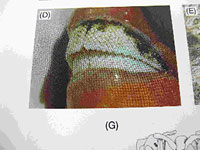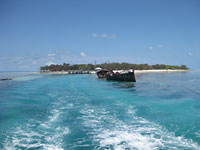

 | |||||||||||||||||||||
|
|
Journals 2009/2010Jacqui Smoler
November 16, 2009 I cannot believe it is my last day! I have really enjoyed my time here. The warm sub-tropical weather with balmy evening breezes and glorious sunsets have been soothing my soul. How will I ever get used to going back into a classroom of teenage boys? Today I had only a half-day to work with the research team so I decided to ask Monika if she required some help. She said that she needed to make permanent slides of her sclerites and so she showed me how to mix up the fixative which is made up of three types of Durcopan solution. She then demonstrated how to mark the slides with a diamond pen so that they would be easily identified back at the university. Two days ago, Monika had placed her sclerites on microscope slides that had been air dried in a food drier in preparation for permanent fixation. Three drops of the viscous Durcopan solution were carefully placed over the top of the dried sclerites and then a coverslip was gently but firmly placed on top and pressed flat from the middle outwards. Monika liked to photograph her specimens with a Canon G10 digital camera which was a popular model amongst the scientists in the research team.
Later that morning I was speaking to another marine worm expert Dr Pat Hutchings, a Senior Principal Research Scientist at the Australian Museum in Sydney, who began her PhD in 1967. I told her that my husband had been snorkeling the other day on the reef around Heron Island and could hear the sounds of Parrotfish feeding on the coral. Pat said that she wanted to show me a book in the library which had a photo of the jaw of the Parrotfish. We walked over to the research station's library which was adjacent to the laboratories and Pat opened up a huge cabinet and took out a large book with the title, "Great Barrier Reef." Inside the book she flicked to a page that had the photo that she wanted to show me. According to Pat, the Parrotfish teeth scrape the algae off the coral when feeding which is clearly audible underwater. It is nice to know that my husband, David, was not going mad. Pat humbly confessed to me in the library that she was the main author of the very book that she had shown me and that she was very proud of it. I had a good look through it and decided that it would definitely be a worthwhile purchase later down the track.
|
||||||||||||||||||||




